If you are a baseball purist, you’re going to hate this. Even if you are not a purist per se, you may very well hate this. I’m fine with that. I know there are going to be elements of all of this that will feel clunky or maybe even over-complicated.
As Icona Pop put it, “I don’t care. I love it”
The Beginning
This idea was borne out of a conversation that took place between two of Pitcher List’s own: Austin Bristow II and Alexander Chase, who also happens to be my podcast partner, co-host of Dugout Study Hall, soccer fan, and all-around fairly decent bloke.
While guesting on an episode of the PitcherListPods “On the List,” Alexander brought up the idea of a realignment plan that would result in four large divisions, geographically based, that contained teams from both the current National and American Leagues (because the universal DH will obliterate the last remaining meaningful difference between the two).
I loved the idea, but I felt like it needed to be kicked up a notch. And so, here we are, BAM! with the Emeril Lagasse version. Before we get into the nuts and bolts of my radical realignment plan (and to be clear by “radical” I mean both revolutionary and totally rad), I want to be clear about the premises and multiple purposes (purposi?) of the system.
- Besides being flat out awesome, this system also attempts to:
- Incentivize paying players their due
- Punish teams for failing to reinvest profits into the team
- Disincentivize tanking
- Make the regular season mean more
- Make the game more interesting
- Make baseball more appealing to a younger audience
- Annoy self-proclaimed “baseball purists”
I cannot emphasize this enough: number 7 is not a throw-away but rather a priority because most people screaming about the purity of baseball are naively fooling themselves that there has ever been such a thing and are often stodgy holier-than-thous who believe that they are the gatekeepers of a game that belongs to everybody. Baseball needs a serious shakeup and this would most certainly do it.
But, I digress.
So here is my radical realignment plan that includes so much more than just changing the divisions, but does start where Alexander left off.
The Basics
There would be four divisions, but unlike Chase’s geographic regions that would still result in weakness in the middle of the country, these would be dynamic; reconstituting themselves to reflect the competitive balance of the moment. Thomas Jefferson said, “Every generation needs a new revolution,” and while that might be a little much, the idea of reinvention to meet the needs of the ever-changing landscape of Major League Baseball isn’t crazy and might be downright necessary.
These four divisions would not be of equal standing, acting more like tiers and borrowing from the concept of relegation that comes to us from soccer. In those “football” setups, teams compete across multiple leagues and a team’s placement is determined based upon its performance from the prior year. Here’s a very basic primer on how it works:
Let’s put 10 teams in 2 leagues (5 teams per league) and call them A-League and B-League. A-League is where it’s at in terms of prestige and honor. If teams in 2020 finished like this:
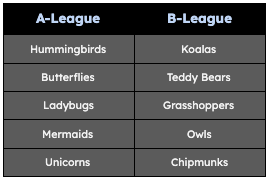
Putting aside the fearsome team names, this would mean that in 2021, the Mermaids and Unicorns are relegated to the B-League and the Koalas and Teddy Bears get promoted to the A-League. And while my proposal below is not true relegation, it builds upon the concept in a way that could be a powerful force in MLB for many reasons, not the least of which being that it would give far more teams something to play for all year and up until the bitter end.
Each year, divisions would be determined based upon the previous year’s regular-season record regardless of playoff outcomes. The number of guaranteed playoff spots would be based upon tier. Here is what the structure would look like for 30 teams (with a 2-team expansion, each division would have 8 teams):
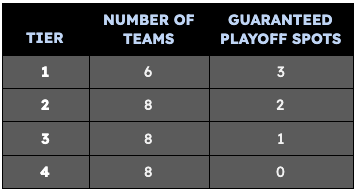
In places where teams were tied for the last spot in a tier, the number of wins in-division would be the tie-breaker (then total runs scored, then some other factor that can be decided upon by the powerful people at MLB).
For next year in 2022, divisions would therefore look like this:

The Playoffs
In order to incentivize winning and punish losing, the number of automatic playoff berths would be based upon the tier. With 3 automatic spots in Tier 1, it is desirable to be in that division. Likewise, with 0 automatic spots coming from tier 4, owners would NOT want to lose.
The teams with the three best records in Tier 1 would be akin to the division winners we have now. The top two teams in Tier 2 would also make the playoffs along with the best team in Tier 3. That would give us a total of 6 teams. But I’m not stopping there.
We get to 10 teams with the last 4 spots going to the best records not already in the playoffs (with this being the ONLY way a tier 4 team could make the playoffs). The top 2 teams get byes in round 1, the remaining 8 teams play best of 3 series. The bye teams get folded back in after the first round for 5 game series until the semi-finals and finals which would be best of 7. It’s more of a tournament, there is no one game play-in, and it shouldn’t take too much longer. Couple that with a 154-game season* and we’re in business.
*A different topic for another piece but something that MLB should definitely do.
What it Looks Like in Action
So you can see above what the division for next year would look like under this system. Now it’s time to go backward and re-imagine how this system would have impacted things from 2020-2021 if it had been in place.
Here are the divisions that would have existed for 2021 based on 2020 records (please note that using 2020 results adds additional chaos to the chaos because it was only a 60-game season):
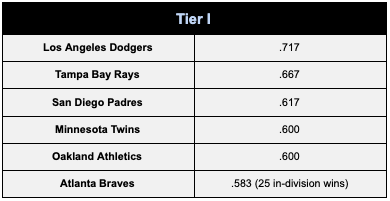
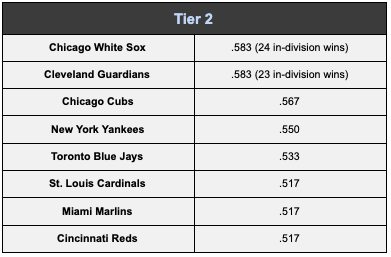
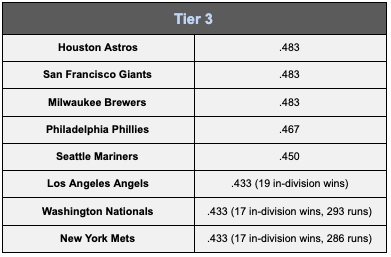
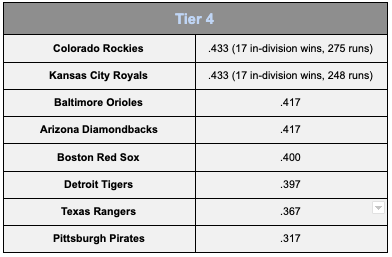
With those divisions established, let’s overlay their 2021 records and see who would have made the playoffs and had the byes, and then we can look at a bracket. With that, you can have some fun imagining how it would have all played out:
Tier 1 Automatics
Los Angeles Dodgers (106-56), Tampa Bay Rays (100-62), Atlanta Braves (88-73)
Tier 2 Automatics
Chicago White Sox (93-69), New York Yankees (92-70)
Tier 3 Automatics
San Francisco Giants (107-55)
Wild Cards
Houston Astros (95-67), Milwaukee Brewers (95-67), Boston Red Sox (92-70) Toronto Blue Jays (91-71)
For seeding purposes, the automatic qualifiers would be seeded by record with Tier being the first tie-breaker, then total runs scored. The Wild Cards would be seeded in the last four spots, ordered by their regular-season records, then Tier, then total runs scored. The bracket would have looked like this:
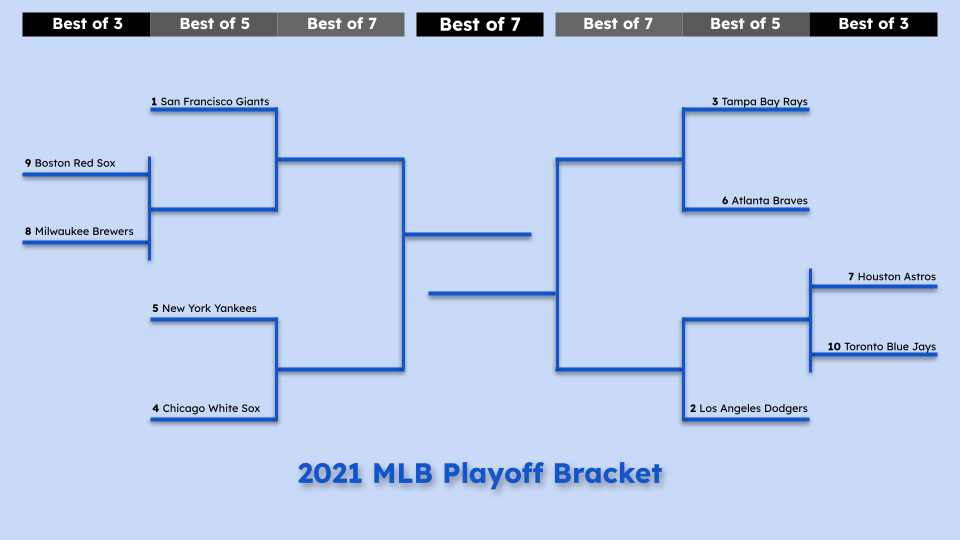
Who wins this? Did the right teams make it in? What are the consequences of being in the lower tiers? Do teams tank with this system? LET’S TALK ABOUT ALL OF THIS!
Some Final Thoughts
Here are a few bullet points that are still rattling around in my head-hole about all of this (and I’m sure you have feelings about some of this too):
- This system probably reads as being a bit more complicated than it really is.
- It provides a framework that could be used to change the way draft picks are allocated as well to further push anti-tanking. For example, the first pick could go to the winner of Tier 4. That way teams that need the help get it, but there is a reason to play to win, not to lose.
- Scheduling would be an enormous factor in the outcomes here; I would advocate for balanced schedules so that wild card records are as fair as possible, but you could make a salient argument that in-division play would matter even more and be the chance a decent team in Tier 4 would need to make the playoffs. I’m okay with that too.
- It’s a huge shift, but with great risk comes great reward (also great risk comes with great risk).
- The idea here is to make things more dynamic and less static; to make things more interesting and engaging.
- The end of the season would matter for so many more teams and for so many more reasons.
- Maybe there are places where it’s broken, but there are already places where things are broken. Maybe you think there’s a better way or a tweak or that the tie-breakers stink. Great! Let’s talk about that.
There may be some pitfalls or issues contained herein, but none of that is a reason not to try something like this.
Let’s get after it, MLB.
Photo by Mark Goldman/Icon Sportswire | Design by Michael Packard (@designsbypack on Twitter @ IG)


Overall I like it. My biggest question is, ‘Would there be any incentive for a team to be in a lower tier?’ If a balanced schedule then I would think no. Theoretically (if expanded to 32 teams) 7 of the 10 teams could come from Tier 1.
If schedules were weighted on tiers then could you not see teams that were near the bottom of tier 1 possibly try to move to tier 2? Assuming 8 teams, then lets look at teams in the 6/7th seed. Lets say the team in the 6th spot is out of those wildcard playoff spots. While I believe players (almost) always give their all, there could be managerial/roster moves to try and lose down to the 7th seed, no? Lets move Chicago and Cleveland up a tier from 2020 for this year and stick 2 imaginary sub 500 expansion teams in tier 4.
Tier 1 now finishes in this order Dodgers (A1), Rays (A2) White Sox (A3) Braves (4th 88 Wins), Athletics (5th 86 wins), Guardians (6th 80 wins), Padres (7th 79 wins), Twins (8th 73 wins). Could you not argue that the Padres have an easier path to playoffs next year based on schedule then over the Guardians especially as Houston and Milwaukee move up to tier 1?
Correct me if I’m wrong, but looking at this season, as is with 6 teams in tier A the only difference in playoff seeding would have been Toronto over St. Louis. And until the league expands to 32 teams I agree that is the way to go.
Now here’s a big kicker– Lets assume again we have two sub .500 teams that were added to tier 4. If you moved the top 2 teams from the bottom three tiers up a tier, Boston still would have made it from Tier 4 and Tier 3 would have only had 1 team in the Giants qualify instead of 3 as the Brewers and Astros would have been in tier 2 and automatic qualifiers at that (Based on 2020 division record tiebreaker, but these three teams could be swapped in any order and have the same effect this year). As mentioned above the Dodgers, Rays, and White Sox are the tier 1 qualifiers. That leave 3 wildcard spots and each of those would have gone to Tier 2 teams- Yankees, Blue Jays and Cardinals… which leaves the 2021 World Series Champion Braves on the outside looking in.
Obviously coming off 2020 we had some unexpected finishes and placements that probably would have greatly altered tiers but it offers lots of hypotheticals.
Would/Should the World Series Winner automatically get moved up into Tier 1 for the following season and if so could 3 teams get relegated down if applicable? Fun exercise and I am all for incentivizing winning.
Why have a universal DH? Be much better if MLB got rid of the DH completely.